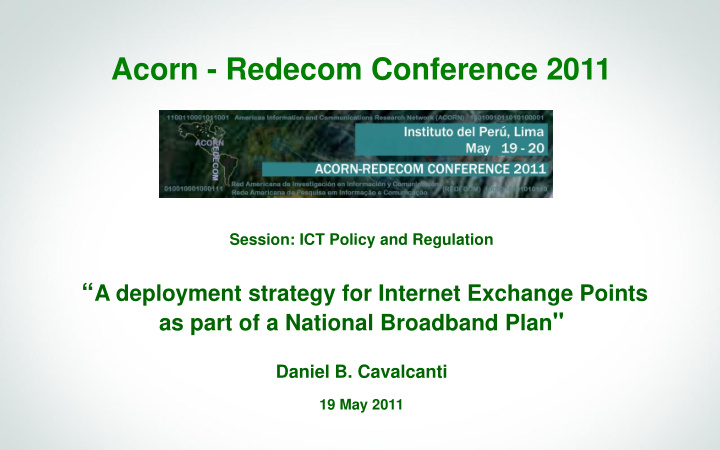



Acorn - Redecom Conference 2011 Session: ICT Policy and Regulation “ A deployment strategy for Internet Exchange Points as part of a National Broadband Plan " Daniel B. Cavalcanti 19 May 2011
Set of switches/routers at a physical location (co-location). Networks and service providers exchange traffic: The Peering: direct exchange between autonomous systems (no payment). Internet Transit: one network carries traffic for the other (wholesale customer). Exchange Benefits of IXPs (positive externalities): Point Reduce costs and bandwidth requirements. (IXP) Improve Internet topology and routing efficiency. Increase fault tolerance. Reduce latency. Neutral.
THE CASE FOR IXPs IXPs provide a level playing field for interconnection (multiple providers present at that point, transit and peering relations possible). However, incumbent network backbones have no incentive to provide neutral exchange points (given the choice, they prefer to maintain asymmetrical relation with smaller networks). Interconnection tends to be a standard regulatory requirement. Nonetheless, special requirements (such as mandatory presence at open and neutral Internet Exchange Points) should be set for providers with significant market power (SMP), or who control a special competitive bottleneck (eg. national backbones and access to submarine cables).
The Internet Exchange Point (IXP) IXP Transit
REGULATORY QUESTIONS What are the key structural problems affecting prices and competition in the broadband market in Brazil? Vertically Integrated Networks (backbone, backhaul and access) International IP Transit (access to submarine cables) How to effectively tackle these problems? New fiber networks (build, lease existing, auction existing, etc.) Internet Exchange Points (simple, inexpensive, structural)!
IXP = PTT ( Ponto de Troca de Tráfego ) INCREASE THE NUMBER AND DISTRIBUTION OF IXPs IN BRAZIL Target: “at least 1 per Area Code” Comitê Gestor da Internet no Brasil ( Brazilian Internet Steering Committee ) Brazil 67 Telephony Area Codes IXP Currently 16 Neutral IXPs Operated by CGI.br (+4 in last 12 months) Target of +52 (at least 1 per Area Code by 2014)
IXP = PTT ( Ponto de Troca de Tráfego ) Americana (SP): population 205.000 São Paulo (SP): population 11 Million PTT São Paulo 185 Participants PTT Americana 11 Participants
CONCLUSIONS Proposed horizontal regulatory measures in the area of IP interconnection: Increase the number of IXPs and ensure wider geographic distribution. Mandatory presence of incumbent backbone networks at these IXPs. Ensure access to backbone and backhaul infrastructure by small and medium-sized local access providers and network operators. Reduce cost of IP transit by providing competition at these IXPs (if competitors present at IXP, then easy to migrate). Increase local peering activity.
THANK YOU! GRACIAS! Daniel B. Cavalcanti danbrc@gmail.com
Recommend
More recommend